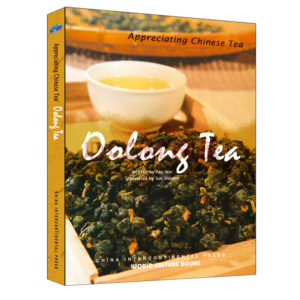Description
Author: Wei Pan
Publishing house: China Intercontinental Press
Edition: 1 (Jan. 2010)
Page: 160
Format: 32
Preface:
Lay the teapot and cups, prepare boiling water and the fragrant Oolong tea will transport you far away through the process of making and drinking tea. For today’s generation, drinking tea is not merely easing thirst, rather a tradition to be savored. Breathe in the fragrance, watch the water turning bright yellow, take a sip, and enjoy the rich fragrance, which is tinged with a mild bitterness. Feel rejuvenated by the flavor and taste. Tea is more rewarding to those who give their heart and soul to tea making and tasting, than those who don’t. The fragrance of tea relieves loneliness and stress.
Abstract:
Why is tea the National drink of China? Why is tea regarded as symbolizing the harmony and mysterious unity of the Universe? Why is the loose-leaf Chinese tea more beneficial than the tea bags? How many types of Chinese tea are Available? How to make the best cup of Chinese tea? ……A visitor to the home of tea has so many questions. Understanding their answers will bring you closer to the history and mystery of tea. Appreciating Chinese Tea Series will help you.
Content:
Part 1 An Introduction to Oolong Tea
Chinese Tea Classification and Oolong Tea
North Fujian Oolong
South Fujian Oolong
Guangdong Oolong
Ginseng Oolong
Part 2 olong Tea Manufacturing
Picking
Frying
Rolling
Drying
Part 3 olong Tea Making
Oolong Tea and Gongfu Tea
Water Is the Mother of Tea
Oolong Tea Set–the Smaller the Better
The Four Key Points in Making Oolong Tea
Tea Ceremony
Tea Etiquette
Part 4 Appreciation of OolongTea and Others
Appreciation of Oolong Tea
Health and Beauty in Oolong Tea
The Preservation of Oolong Tea
Part 5 Study Tea Art and BecomTea Specialist
Lets Learn Tea Art
Where to Learn Tea Art
What Is Involved in Tea Art Training
How to Obtain Tea Specialist Certificate Assessment
Appendix
Preview:
IV. Reprocessed Oolong Tea
Reprocessed Oolong tea, such as Dahua Oolong and Guihua Oolong, is made by reprocessing the final product Oolong with gardenia (Dahua, literally “big flower”), osmanthus (Xiaohua, literally “small fl ower”), etc., that is, adding the fragrance of fl owers to middle and low grade Oolong.
This process originated in Anxi, where they used two kinds of flowers, gardenia (Dahua) and osmanthus (Xiaohua). Gardenia are big and white, with a strong scent. They bloom 10 to 20 days after the spring tea picking. The fl owers bloom for a month; the fi rst twenty days producing the best fl owers. Osmanthus, including thunbergii (the best), latifolius and aurantiacus, has small golden fl owers, rich in fragrance. They bloom in late September, lasting only six to eight days, the early fl owers having richer fragrance.
The raw materials are middle- and low-grade tea, called “rough tea.” Rough tea must be thoroughly dried and re-dried—the drier tea absorbs better fl ower fragrance.
The quality of fl owers determines the quality of the Oolong Flower Tea. Dahua must not be plucked during rain because it will increase the moisture and damage the fragrance. After picking, the blossoms must be trimmed and withered immediately to reduce moisture for fragrance. Xiaohua blossoms are processed after sun-drying and trimming.
Flower tea manufacturing is the process of tea leaves absorbing fl ower fragrance, during which the rough tea and fl owers are mixed by piling tea leaves interlayered with fl owers. The pile is usually 50 cm high, but may vary according to the temperature. The ratio between the rough tea and fl owers is 10:4 for Dahua and 10:3 for Xiaohua (may vary according to fl ower quality and demand).
Stir the pile two to three times and lower the temperature. The process is completed when the flowers turn brown, at which time the tea should be separated with flowers and dried immediately to prevent from going bad. Xiaohua Oolong is usually dried before being separated from fl owers.
After drying and airing, the tea and flowers should be blended again. (Unlike jasmine tea, Oolong is drinkable right away.) Reprocessing is completed. The usual ratio between fl owers and tea is 4:96.
Ginseng Oolong
Ginseng Oolong is a special kind of Reprocessed Oolong, made by processing tea leaves with ginseng leaves or crushed ginseng, together with some other ingredients. Good quality Ginseng Oolong has medical functions.
Tips
It is not diffi cult to judge the quality: During infusion, the brewed leaves spread—the quicker the better. Much of the Ginseng Oolong in the market is made from aged tea, so great care is needed when purchasing.



























